#its a Dickens story
Text
Can't stop thinking about how so many of Dickens's major characters are shaped by their backstories and yet Sydney Carton's past is almost completely left in the dark.
#its giving silver of black sails. 'i have no story to tell'#i really want to reread the book again to look for every hint at his past because its fascinating how little there is#how did he become who he is? we have no idea. theres no rhyme or reason to it. 'not unremarkable. just... without relevance.'#a tale of two cities#charles dickens#fuck off me
2 notes
·
View notes
Text
i HATE how the name 'scrooge' has become an insult aimed at people who are deemed 'too greedy' or 'bad because they don't like and/or celebrate xmas.' he literally gets redeemed. the whole story is about him becoming a better person.
it's antisemitism, isn't it? like that is the only reason why 'scrooge' is an insult.
NON JEWS LAY OFF. you may interact but if u clown on this u will be blocked.
#this post is not about antisemitism within a christmas carol itself bc while there are negative stereotypes present in it#and it certainly Can Be antisemitic (like in certain adaptations) it really isn't a black and white thing. like yeah scrooge falls into#negative stereotypes about jews. no he isn't actually meant to be jewish. yes his name is constantly leveraged as an insult against jews.#he literally becomes a better person at the end. yes this is framed through his acceptance of xmas. no it isn't like a merchant in venice#with shylock converting at the end but it does echo of it.#like yes!!! it has fueled a shit ton of antisemitism. no scrooge is not actually jewish. yes many portrayals and#adaptations ARE deeply antisemitic. the story is not on its own about a jew who has to accept xmas into his life but it could easily be#read as that. charles dickens was more antisemetic about oliver twist apparently but i haven't read it so idk!!!#myevilposts#a christmas carol#sorry everypony a christmas carol is my new obsession and i need to yell about it. no i am not xtain yes it is february.
10 notes
·
View notes
Text
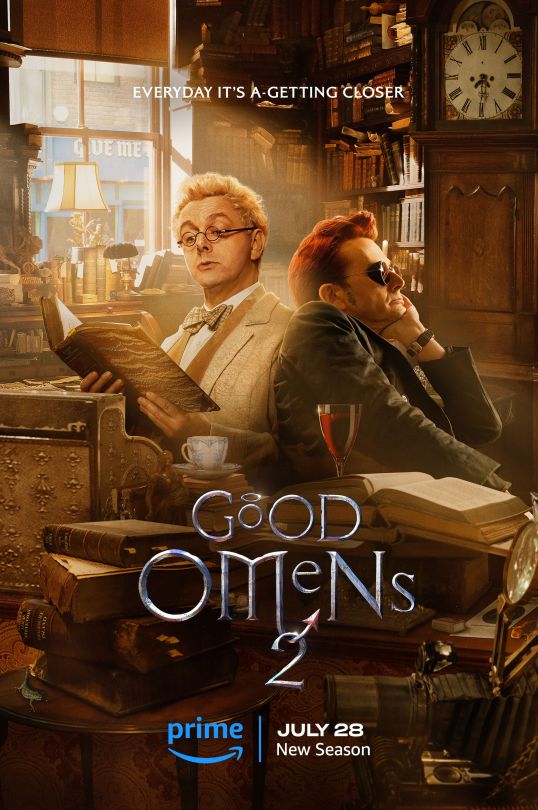
The Season 2 Poster Details
From top to bottom :)

This is a Buddy Holly song Everyday which was originally supposed to be the Good Omens theme :)
Neil talks about it in the Introduction to the Script Book: “In the scripts, Buddy Holly’s song ‘Every Day’ runs through the whole like a thread. It was something that Terry had suggested in 1991, and it was there in the edit. Our composer, David Arnold, created several different versions of ‘Every Day’ to run over the end credits. And then he sent us his Good Omens theme, and it was the Good Omens theme. Then Peter Anderson made the most remarkable animated opening credits to the Good Omens theme, and we realised that ‘Every Day’ didn’t really make any sense any longer, and, reluctantly, let it go. It’s here, though. You can hum it.”
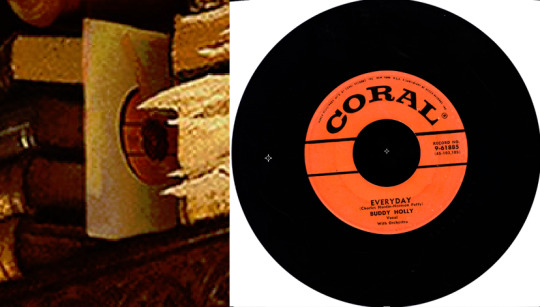
And there is also the Buddy Holly Everyday record! :)

Book The Crow Road by Iain Banks. The novel describes Prentice McHoan's preoccupation with death, sex, his relationship with his father, unrequited love, sibling rivalry, a missing uncle, cars, alcohol and other intoxicants, and God, against the background of the Scottish landscape

Book Lord Jim by Joseph Conrad. An early and primary event in the story is the abandonment of a passenger ship in distress by its crew, including a young British seaman named Jim. He is publicly censured for this action and the novel follows his later attempts at coming to terms with himself and his past and seeking redemption and acceptance.
Important themes in Lord Jim include the consequences of a single, poor decision, the indifference of the universe, and the inability to know oneself or others.

There is book The Body Snatcher by Robert Louis Stevenson. Its characters were based on criminals in the employ of real-life surgeon Robert Knox (1791–1862) around the time of the notorious Burke and Hare murders (1828). Neil said: Oddly enough, episode 3 will take us to a little stint of body snatching in the era.

There is Catch-22 book by Joseph Heller that coined the term Catch-22: situation from which an individual cannot escape because of contradictory rules or limitations.
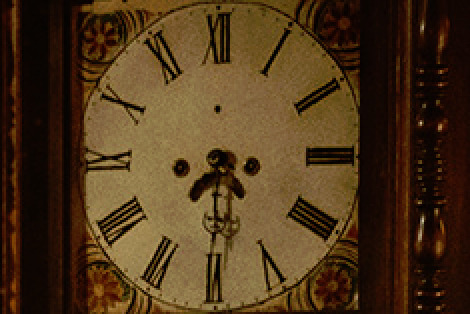
Is there only one hand or are there two? :) EIther 6 ;), or 6:30 :).

Through the window we can see the coffeeshop Give Me Coffe or Give Me Death where Nina works! :)

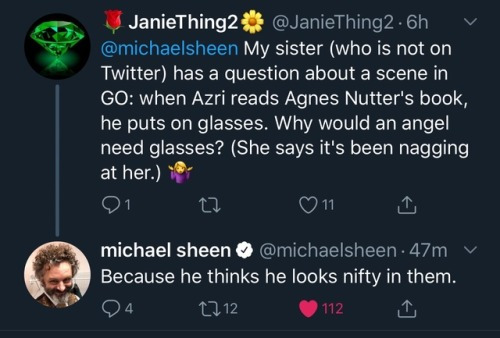
Azi is wearing his nifty glasses :).
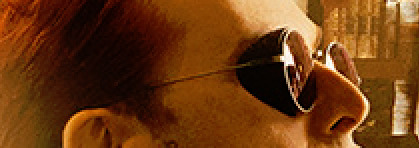

Crowley is wearing his new glasses, they are RIGARDS X UMA WANG - THE STONE ECLIPSE (VINTAGE BLACK/BLACK STONES) - $435



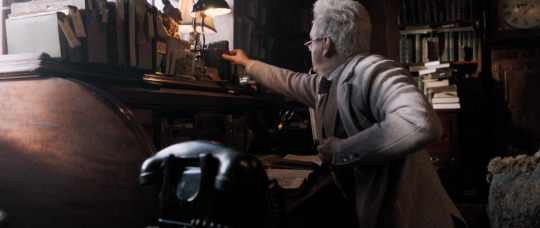
There is the Holy Bible Aziraphale used in Season 1 :)

There seems to be a broken phone :).

The cakes behind Aziraphale are Eccles cakes :).
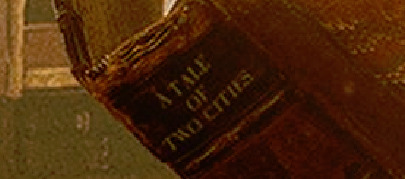
Azi is reading A Tale of Two Cities by Charles Dickens published in 1859, set in London and Paris before and during the French Revolution. The novel tells the story of the French Doctor Manette, his 18-year-long imprisonment in the Bastille in Paris, and his release to live in London with his daughter Lucie whom he had never met. The story is set against the conditions that led up to the French Revolution and the Reign of Terror.


Another book there is Pride and Prejudice by Jane Austen - Neil said said that we will learn a lot about Jane Austin we didn’t know before.
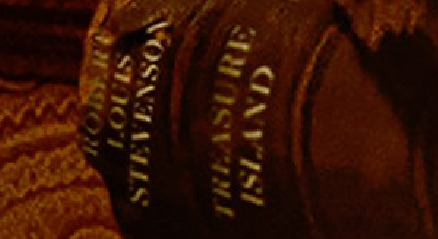
And finally the Treasure Island book by - again :) - Robert Louis Stevenson, an adventure novel with pirates.


There are three geckos cuties. Who are they? Pets? Is Ligur haunting the bookshop? Who knows :).

A mysterious pamphlet, 'The Resurrectionists’ leaflet. (unofficial spoiler :)).

Also there is an old camera... mmm 🤔 Did Azi made some photos (of what? Him and Crowley, ducks? :)) Will we see them? :)
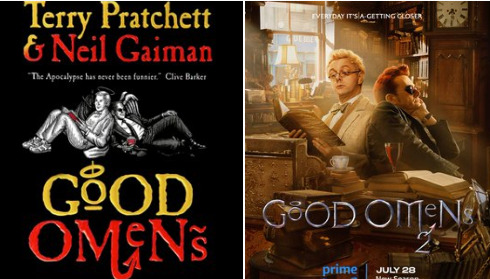
Their positions is an homage to the book covers! :)(x)
Will update this as fandom discovers new things! :)❤
#good omens#gos2#season 2#posters#s2 poster details#fun fact#robert louis stevenson#jane austen#joseph heller#charles dickens#can't waiiiit#wahoo!
6K notes
·
View notes
Note
oooh please tell us what writing rules are garbage I would love to hear more
it's not that they're garbage, which isn't what i said, just that they annoy me and even then what annoys me is not the "rules" themselves (because i do believe they can be useful depending on what you're writing) but when some of them are put out as the only way to write something as if storytelling is a one-size fits all approach, as if you can reduce the millenia-long history of literature into a fail-proof formula that will work for all writing across all cultures with no room for experimentation.
i think there are as many ways to tell a story as there are stories and how you tell something and the kind of language you use will vary depending on what language actually means to you as a writer. hemingway and faulkner both famously took digs at each other for their styles (even though i think there was a lot of admiration between them) but they are also two very different writers with two completely different approaches to language and how they use that language to say the things they want to say: neither is inherently better, or more right, than the other--their approaches were just right for them; if faulkner wanted to write using the "older, simpler, better" words hemingway loved, he would have. if james joyce wanted to depict dublin the way dickens depicted london, he would have done so. but they didn't.
someone once posted an excellent breakdown by jeff vandermeer of the different writing styles employed by different authors which i was silly enough not to save at the time, but in it he gives an overview of the structure of their sentences, and how complicated or "rich" the language is, without pitting one style against the other. and to be honest, i think writing advice that encourages you to examine and look at that relationship with language, and what it holds for you (and others) and why, is probably more helpful than blanket statements like "stay away from ambiguity" or "avoid long sentences" because neither of those actually mean anything--a sentence is a vessel but it's also a tool, like a hoghair brush or a palette knife; the value of its impact is not an essence that exists in and of itself, but entirely dependent on how you use it, otherwise all literature would just read the same way.
strict adherence to a particular form or structure within a language does not automatically make for better writing, especially not when so much literature actually consists of, and is built from, works and authors actively rebelling against those same traditional forms and structures (but which is also not to say that those forms and structures are inherently useless, either). you can say that long sentences "risk distraction" or are "ineffective" but then where does that leave someone like laszlo krasznahorkai, whose prose runs on like some kind of breathless, hypnotic incantantion for 20, 30 pages without a single full stop in sight? or a book like solar bones by mike mccormack which is made up of a single sentence going on for 200 pages? i'm not saying long sentences can't be boring or tedious, but in all honesty so can short sentences--so can any writing that follows the "rules" to the letter. if something is poorly written, the "rules" matter very little; if it's well written, they matter even less.
all that said, telling people to "avoid long sentences" is not inherently a bad thing because i think the core of it is wanting to ensure your writing remains clear, which is a fair point--but it's an issue, to me at least, when it turns into one of those dictums or pronouncements that actively narrows the potential range language can actually have. clarity is not always about length, or whether or not you cull all of your run-on lines--mihail sebastian drew a very nice distinction in one of his novels when he said "[is] there’s a single way of being clear? A notary can be clear, or a poet, but they don’t seem to me the same thing". a long sentence can be clear, but its clarity exists on different terms to a sentence that is five words long, because its relationship to its content is different. and at the end of the day, that relationship is really what it's about for me and it's distinct to each work and its author.
writers use the language and form they use that best allows them to say what they want to say. no one in their right mind is going to dismiss zadie smith for not writing like angela carter or angela carter for not writing like hemingway or hemingway for not writing like beckett or beckett for not writing like mallarmé. robert frost and sara teasdale were no more correct than the beatniks were. i love pared down, beautifully concise prose, but i also adore books that relish in language and all the various, multi-coloured layers of it, books that eschew (traditional) plot and books that question their own form and the reality of that form, and books that tell a story as straightforwardly as possible.
to be honest i think one of the most formative things i came across, years ago now, was this piece by gary provost, which really sums up the whole notion of "writing rules" for me:
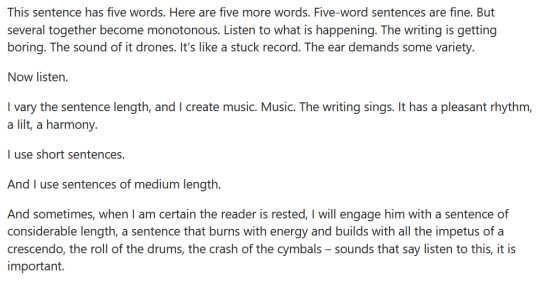
this is not about do's or dont's. it even breaks the first writing rule i learnt in school ("never begin a sentence with 'And'"). but what it does is center an intimate understanding of language, where it can go and how it can get there, and what you want that to do. that's where it's at for me!
601 notes
·
View notes
Text

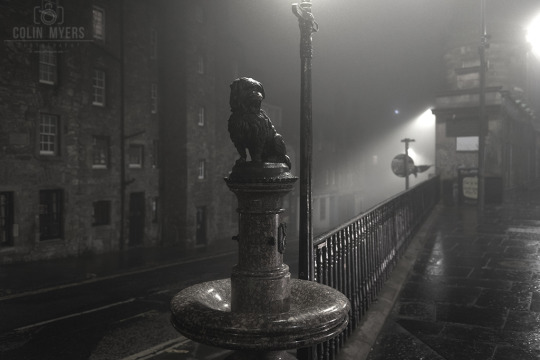


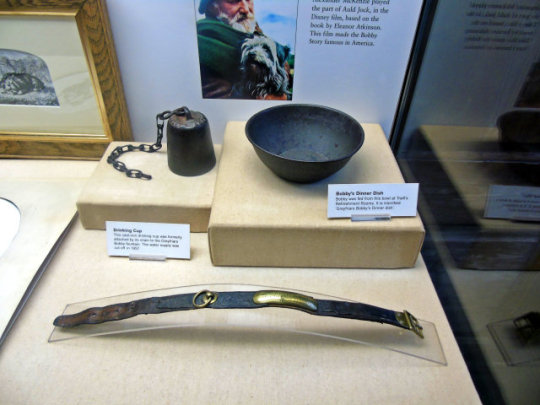
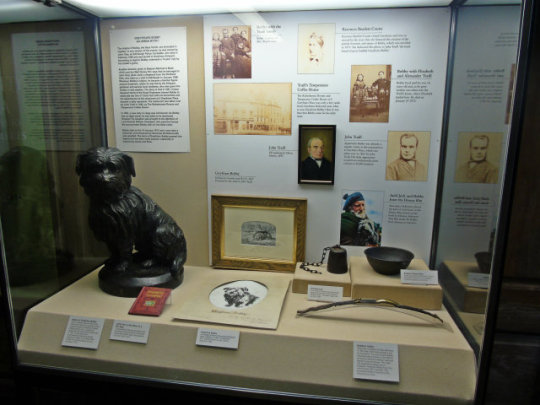

On January 14th 1872 Edinburgh’s world famous dog, Greyfriars Bobby died.
For many visitors to Edinburgh, a must-see is the statue of Greyfriar's Bobby on George IV Bridge and, although it's officially frowned upon, rubbing Bobby's nose for luck. The true story of Greyfriar's Bobby is so enchanting that even Walt Disney decided to make a movie about him.
Greyfriars Bobby was a Skye Terrier who became famous in the 19th century for his unwavering loyalty to his owner. In 1850 John Gray, his wife, Jess and their son John arrived in Edinburgh. John was a gardener but could not find employment in his new hometown, so he worked as a night watchman for the Edinburgh Police Force.
It was a lonely job, so to keep him company, he bought a wee Skye Terrier, who he called Bobby. Soon John and Bobby became inseparable through the long winter nights they maintained a watch over their charges.
Edinburgh's damp and murky weather eventually took its toll on John, who was diagnosed with tuberculosis. Despite treatment from the Police Surgeon, John died on 15th February 1858 and was buried in Greyfriar's Kirkyard.
Bobby, who had never been apart from John, refused to leave the cemetery and stayed by his owner's grave. Despite the efforts of the graveyard staff to evict Bobby, he always returned and eventually, they gave up and provided little Bobby with shelter beside John's Grave.
Word of Bobby's loyalty quickly spread, and he became a local sensation. It is said that crowds would gather outside the graveyard at one o'clock each day. When Edinburgh's famous one o'clock gun was fired, Bobby would leave the grave and join local joiner William Dow for a walk to a local coffee shop.
John and Bobby visited Traill’s Temperance Coffee House on their rounds, and Bobby was always given something to eat by the owner John Traill. This tradition continued after John's passing, thanks to the generosity of the owner.
A new by-law was passed by the Edinburgh Council in 1867, making it mandatory that all dogs had a licence and a collar. The Lord Provost of Edinburgh, Sir William Chalmers, undertook to pay for Bobby's licence, and he received a collar with the inscription "Greyfriar's Bobby from the Lord Provost 1867 Licensed".
If you visit the Museum of Edinburgh on the Royal Mile, you can see Bobby's collar and drinking bowl. as seen in the pics, that I took in 2016/.
Bobby stayed by John's grave for 14 years until he passed in 1872. He was buried in the same cemetery, just a few feet away from his beloved owner.
Greyfriars Bobby's story is one of the most enduring tales of loyalty and devotion. It serves as a reminder of the special bond between humans and animals.
In 1981 a new headstone at Bobby's Grave was unveiled by the Duke of Gloucester. The inscription reads, "Greyfriars Bobby – Died 14 January 1872 – Aged 16 years – Let his loyalty and devotion be a lesson to us all".
The legend of Bobby touched the heart of Baroness Angelia Georgina Burdett-Coutts. She was the daughter of the banker Thomas Coutts (of Coutts Bank fame) and inherited £1.8 million on her grandfather's death, making her one of the wealthiest women in England.
Burdett-Coutts spent most of her wealth on philanthropic causes. She co-founded the Urania Cottage for "fallen young women" with Charles Dickens and became a social housing pioneer.
The Baroness got permission from Edinburgh Council to erect a statue of Bobby at the junction of Candlemakers Row and George IV Bridge, just outside Greyfriars Kirkyard. The artist William Brodie was commissioned to create the statue in 1872.
Since its unveiling, the statue of Bobby has become an important Edinburgh landmark.
152 notes
·
View notes
Photo
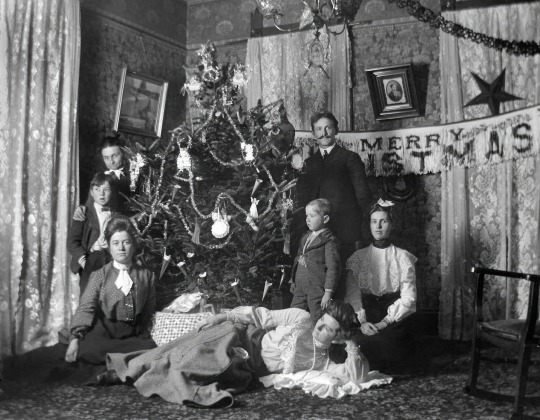
The history of Christmas traditions kept evolving throughout the 19th century, when most of the familiar components of the modern Christmas including St. Nicholas, Santa Claus, and Christmas trees, became popular. The changes in how Christmas was celebrated were so profound that it's safe to say someone alive in 1800 would not even recognize the Christmas celebrations held in 1900.
Washington Irving and St. Nicholas
Early Dutch settlers of New York considered St. Nicholas to be their patron saint and practiced a yearly ritual of hanging stockings to receive presents on St. Nicholas Eve, in early December. Washington Irving, in his fanciful History of New York, mentioned that St. Nicholas had a wagon he could ride “over the tops of trees” when he brought “his yearly presents to children.”
The Dutch word “Sinterklaas” for St. Nicholas evolved into the English “Santa Claus,” thanks in part to a New York City printer, William Gilley, who published an anonymous poem referring to “Santeclaus” in a children’s book in 1821. The poem was also the first mention of a character based on St. Nicholas having a sleigh, in this case, pulled by a single reindeer.
Clement Clarke Moore and The Night Before Christmas
Perhaps the best-known poem in the English language is “A Visit from St. Nicholas,” or as it’s often called, “The Night Before Christmas.” Its author, Clement Clarke Moore, a professor who owned an estate on the west side of Manhattan, would have been quite familiar with the St. Nicholas traditions followed in early 19th century New York. The poem was first published, anonymously, in a newspaper in Troy, New York, on December 23, 1823.
Reading the poem today, one might assume that Moore simply portrayed the common traditions. Yet he actually did something quite radical by changing some of the traditions while also describing features that were entirely new.
For instance, the St. Nicholas gift giving would have taken place on December 5, the eve of St. Nicholas Day. Moore moved the events he describes to Christmas Eve. He also came up with the concept of “St. Nick” having eight reindeer, each of them with a distinctive name.
Charles Dickens and A Christmas Carol
The other great work of Christmas literature from the 19th century is A Christmas Carol by Charles Dickens. In writing the tale of Ebenezer Scrooge, Dickens wanted to comment on greed in Victorian Britain. He also made Christmas a more prominent holiday and permanently associated himself with Christmas celebrations.
Dickens was inspired to write his classic story after speaking to working people in the industrial city of Manchester, England, in early October 1843. He wrote A Christmas Carol quickly, and when it appeared in bookstores the week before Christmas 1843 it began to sell very well.
The book crossed the Atlantic and began to sell in America in time for Christmas 1844, and became extremely popular. When Dickens made his second trip to America in 1867 crowds clamored to hear him read from A Christmas Carol. His tale of Scrooge and the true meaning of Christmas had become an American favorite. The story has never been out of print, and Scrooge is one of the best-known characters in literature.
Santa Claus Drawn by Thomas Nast
The famed American cartoonist Thomas Nast is generally credited as having invented the modern depiction of Santa Claus. Nast, who had worked as a magazine illustrator and created campaign posters for Abraham Lincoln in 1860, was hired by Harper’s Weekly in 1862. For the Christmas season, he was assigned to draw the magazine’s cover, and legend has it that Lincoln himself requested a depiction of Santa Claus visiting Union troops.
The resulting cover, from Harper’s Weekly dated January 3, 1863, was a hit. It shows Santa Claus on his sleigh, which has arrived at a U.S. Army camp festooned with a “Welcome Santa Claus” sign.
Santa’s suit features the stars and stripes of the American flag, and he’s distributing Christmas packages to the soldiers. One soldier is holding up a new pair of socks, which might be a boring present today, but would have been a highly prized item in the Army of the Potomac.
Beneath Nast's illustration was the caption, “Santa Claus In Camp.” Appearing not long after the carnage at Antietam and Fredericksburg, the magazine cover is an apparent attempt to boost morale in a dark time.
The Santa Claus illustrations proved so popular that Thomas Nast kept drawing them every year for decades. He is also credited with creating the notion that Santa lived at the North Pole and kept a workshop manned by elves. The figure of Santa Claus endured, with the version drawn by Nast becoming the accepted standard version of the character. By the early 20th century the Nast-inspired version of Santa became a very common figure in advertising.
Prince Albert and Queen Victoria Made Christmas Trees Fashionable
The tradition of the Christmas tree came from Germany, and there are accounts of early 19th century Christmas trees in America, but the custom wasn’t widespread outside German communities.
The Christmas tree first gained popularity in British and American society thanks to the husband of Queen Victoria, the German-born Prince Albert. He installed a decorated Christmas tree at Windsor Castle in 1841, and woodcut illustrations of the Royal Family’s tree appeared in London magazines in 1848. Those illustrations, published in America a year later, created the fashionable impression of the Christmas tree in upper-class homes.
By the late 1850s reports of Christmas trees were appearing in American newspapers. And in the years following the Civil War ordinary American households celebrated the season by decorating a Christmas tree.
The first electric Christmas tree lights appeared in the 1880s, thanks to an associate of Thomas Edison, but were too costly for most households. Most people in the 1800s lit their Christmas trees with small candles.
The First White House Christmas Tree
The first Christmas tree in the White House was displayed in 1889, during the presidency of Benjamin Harrison. The Harrison family, including his young grandchildren, decorated the tree with toy soldiers and glass ornaments for their small family gathering.
There are some reports of president Franklin Pierce displaying a Christmas tree in the early 1850s. But the stories of a Pierce tree are vague and there doesn't seem to be contemporaneous mentions in newspapers of the time.
Benjamin Harrison's Christmas cheer was closely documented in newspaper accounts. An article on the front page of the New York Times on Christmas Day 1889 detailed the lavish presents he was going to give his grandchildren. And though Harrison was generally regarded as a fairly serious person, he vigorously embraced the Christmas spirit.
Not all subsequent presidents continued the tradition of having a Christmas tree in the White House. By the middle of the 20th century, White House Christmas trees became established. And over the years it has evolved into an elaborate and very public production.
The first National Christmas Tree was placed on The Ellipse, an area just south of the White House, in 1923, and the lighting of it was presided over by President Calvin Coolidge. The lighting of the National Christmas Tree has become quite a large annual event, typically presided over by the current president and members of the First Family.
Yes, Virginia, There Is a Santa Claus
In 1897 an eight-year-old girl in New York City wrote to a newspaper, the New York Sun, asking if her friends, who doubted the existence of Santa Claus, were right. An editor at the newspaper, Francis Pharcellus Church, responded by publishing, on September 21, 1897, an unsigned editorial. The response to the little girl has become the most famous newspaper editorial ever printed.
The second paragraph is often quoted:
"Yes, VIRGINIA, there is a Santa Claus. He exists as certainly as love and generosity and devotion exist, and you know that they abound and give to your life its highest beauty and joy. Alas! how dreary would be the world if there were no Santa Claus. It would be as dreary as if there were no VIRGINIAS."
Church’s eloquent editorial asserting the existence of Santa Claus seemed a fitting conclusion to a century that began with modest observances of St. Nicholas and ended with the foundations of the modern Christmas season firmly intact.
By the end of the 19th century, the essential components of a modern Christmas, from Santa to the story of Scrooge to strings of electric lights were firmly established in America.
Source
182 notes
·
View notes
Text
Since A Dickens December just recently covered the scene in A Christmas Carol, where Fred and his guests play Yes and No, I've found myself comparing the book scene to its equivalent in The Muppet Christmas Carol. In the book, the humor at Scrooge's expense is balanced by Fred expressing his compassion for Scrooge, who, as he watches invisibly, takes the joking in stride and ends the scene in a happy mood. But in the Muppet movie, Fred's compassionate speeches about Scrooge are cut, leaving only the insulting humor (which is reworded too – instead of "rather disagreeable" and "a savage animal," Scrooge hears himself called "an unwanted creature") and Scrooge is hurt when he hears it.
During last year's Dickens December, I seem to remember some criticism of the Muppets' version of the scene, since it alters the scene's entire meaning and does a disservice to Fred's character. That's a valid critique.
But I want to try to analyze what makes it work within the movie.
Not only is the scene rewritten in the Muppet version, it's also placed before the visit to the Cratchit family rather than after. The order of the entire Ghost of Christmas Present sequence seems to be altered in the movie to create a "rising line of tension." (A quote from Robert Wise about the re-ordering of songs in the 1961 film of West Side Story compared to the stage version.)
Both versions of Scrooge's travels with the Ghost of Christmas Present open with the Ghost showing him the happy hustle and bustle in the streets on Christmas morning. Then, in the book, they visit the Cratchits: a happy scene in general, but increasingly bittersweet with the evidence of the family's poverty and with Tiny Tim's illness, and increasingly grim for Scrooge, first with the Ghost's foretelling of Tim's death and throwing Scrooge's own callous words about the "surplus population" back at him, and then with Mrs. Cratchit's disgust and the children's gloom when Bob proposes a toast to him. But after this comes a moody yet uplifting sequence where the Ghost takes Scrooge to various harsh, gloomy places – a miners' hut, a lighthouse, a ship at sea – where nonetheless, Christmas brings people joy. And then comes the joyful scene at Fred's party, where Fred laughs and jokes about Scrooge, but at the same time reveals his compassion for his uncle and makes it clear that his door is always open to him. Throughout these visits, Scrooge's emotional engagement steadily increases, culminating in his being swept up in the joy of Fred's party, forgetting that no one can see or hear him and joining in the games, and ending the visit "gay and light of heart."
The Muppet version changes the order of events to create a steadier line from joyful to poignant. The bustling street sequence is accompanied by the song "It Feels Like Christmas" (one of the best Christmas movie songs of all time). In a less moody and more lighthearted, Muppety way than Dickens, the song also encompasses the theme of "Christmas brings joy to even the poorest and harshest places" (e.g. to the poor mouse family, and to the prisoner and the jailor who act like friends for the day). Throughout the song, Scrooge slowly becomes engaged, and finally, awkwardly yet joyfully dances along with the Ghost.
Afterwards, swept up in the newly-discovered joy of Christmas, Scrooge asks to see family, so the Ghost accordingly takes him to his only family, Fred. Scrooge enters the scene still on an emotional high from the last one, unironically calling Fred his "dear nephew" and happily joining in the game while forgetting that he's invisible. But then, like a punch or a kick, he hears himself called "an unwanted creature," and sees everyone laughing at his expense. At this point the book's Scrooge has already been reminded of how others feel about him by Mrs. Cratchit, and worse, he's already had to face the fact that Tiny Tim might die because of his callousness. This, combined with Fred's compassionate talk, lets him take the mocking in stride; it's mild compared to what he's heard and realized about himself already. But for Michael Caine's Scrooge, it's a startling and brutal reminder of how he's alienated himself from others, just as he's been realizing how much joy friendship and family can bring.
Then the film's version of the Christmas Present sequence culminates with the bittersweet Cratchit family Christmas, and with Scrooge's realization that Tiny Tim might die because of him.
I understand feeling as if the Muppet version does Fred a disservice by cutting his compassionate speeches in the party scene. But his goodwill and eagerness to reach out to Scrooge are still conveyed in his visit to Scrooge's office at the beginning, and including his compassionate speeches might have broken the line of tension described above.
"Rising lines of tension" seem to be generally considered more important in film than they are in books. Notice how most adaptations of A Christmas Carol, including the Muppet version, slightly change Scrooge's emotional journey in the Christmas Past scenes too. In the book's Past sequence, his biggest emotional breakdown is over his childhood – he breaks down crying at the sight of his younger self all alone at Christmas in the miserable school. But the film versions always break him more slowly; he shows restrained sadness when he sees his lonely child self, but doesn't break down in tears until a later point, usually when Belle leaves.
Another comment is I'd like to make is that in The Muppet Christmas Carol, Scrooge's character arc is framed around his loneliness, his realization that he wants love in his life (both to give it and receive it), and his ultimate desolation at how alone and unloved he is because of his own greed and cruelty. Followed, of course, by joy as he finally gives love to others and receives it in return. I'm not sure if this is exactly Scrooge's arc in the book, but onscreen it works.
Analyzing the changes in adaptations, and determining why they work onscreen or onstage (though without trying to claim that they're improvements) is something I could do for hours. Someday I might want to write a whole essay about how, in the musical of Les Misérables, "A Little Fall of Rain" is arguably the most poignant death scene in the show and one of the most moving deaths in any Broadway-style musical – even though some people validly argue that it's much too romanticized and sentimental compared to Éponine's death in the novel, and that it dilutes her tragedy by having Marius grieve for her instead of just coldly pitying her. While of course it's always nice to see a meticulously faithful adaptation of a book, sometimes certain changes do work well.
191 notes
·
View notes
Text
Charles Dickens: ok guys today i'm gonna tell a spooky ghost story
Edgar Allan Poe: what the
Poe: what is THAT
Dickens: oh this? this is my pet raven Grip
Poe:
King:
Barker:
Koontz:
Lovecraft:
Dickens: say hello, grip
Grip: halloa old girl
HP Lovecraft: grip? that's a funny name for a bird
Dickens: why? what would you-
Dickens: oh you sly devil
Lovecraft: what?
Dickens: you almost got me there
Poe: whoa whoa whoa
Poe: your raven can talk??
Dickens: that's right
Poe: OH
Poe: MY
Poe: GOD
Dickens: you know the raven in barnaby rudge?
Poe: yeah?
Dickens:
Poe: [in disbelief] NO!!
Poe: that was based on..???
Dickens: yup exactly
Koontz: what's going on edgar?
Poe: this is the most amazing bird that I've ever seen in my life!
Dickens: check this out
Dickens: watch what she does with this piece of cheese
Barker:
Dickens: eh? eh? see what she's doing
[Grip proceeds to bury cheese in ground]
Barker: she's burying it in the ground?
Dickens: yeah
Dickens: ain't that something
Dickens: ok check this out, grip can really talk
Dickens: ok grip what's on top of a house?
Grip: halloa old girl
Dickens: how does sandpaper feel?
Grip: halloa old girl
Dickens: who's the greatest baseball player of all time?
Grip: halloa old girl
Poe: this bird is amazing!
Dickens: oh that's not all
Dickens: i also trained her to attack hans christian andersen on sight
Poe: this is incredible
Grip: halloa old girl
Poe: holy shit she said it again!!
Poe: guys did you hear that??
Barker: yes edgar we all hear it
Grip: halloa old girl
Grip: halloa old girl
Poe: wowwwwww
Barker: its not THAT interesting
Barker: i didn't know you were so into birds edgar
Barker: always figured that for more of a Stephen Gregory thing
Poe: no listen this bird TALKS
Grip: halloa old girl
Poe: i'm going to put this in my next story
Barker: what, a talking bird?
Poe: GOD, it's gonna be SO COOL
Poe: I fucking love ravens!
Barker: oh my god
Barker: turns out that anti-subtext meme comic was right this whole time!
Franz Kafka: oh hi i see you brought a raven?
Dickens: yes
Grip: halloa old girl
Kafka:
Kafka: [blushes]
#midnight pals#the midnight society#midnight society#stephen king#clive barker#edgar allan poe#dean koontz#hp lovecraft#franz kafka#charles dickens
161 notes
·
View notes
Text
Things of Note at @neil-gaiman ‘s NJPAC talk:
1. Do you people understand that he switches into accents when he reads? Do you people know he does a perfect Michael Sheen impression? did you know it’s also hot
2. He used to cold call publishers/mags to see if they’d publish his work. He’d lie when asked what other magazines he wrote for; they’d think he was more legitimate and would, therefore, be more likely to take him on themselves. “You couldn’t get away with that now” thanks to Google. Also, back then, “we had telephones and we used them,” but today’s publishers would not easily recover if you unexpectedly called them on the phone.
3. It was a personal point of pride for Neil to write for each of the magazines he’d claimed to have written for. He said “I didn’t lie. I was chronologically challenged.”
4. Neil made a deliberate effort to not be boxed in by publishers. He’d interviewed many authors who were unhappily boxed and did everything he could to avoid it, including declining big contracts from prestigious publishers (notably after American Gods). This is why he can write what he likes now. Comics writing spoiled him in this regard, as publishers mistook the medium for a genre, and therefore didn’t care what he wrote (so he wrote all the genres he wanted to in Sandman).
5. He hates Thomas Hardy thanks to being introduced to him in school. Regarding being forced to read Tess of the D’urbervilles, he said “I wouldn’t do that to a dog”. He hopes students, who might have liked him if they found him on their own, don’t encounter his work in school and hate him for it.
6. “The evil characters (you write) don’t possess you, you try to find the little bit of you in them….the little bit of you that is gloriously evil.”
7. “I touched the magic and passed it along” this was a line from Watching from the Shadows that especially moved me.
8. Terry was increasingly upset as the bidding on Good Omens increased (eventually reaching 150,000 - can’t remember if he said $ or £). For his part, when the book finally sold, Neil put on Iggy Pop’s Success and danced.
9. Anansi Boys should be out on Prime by the end of 2024!
10. Described Sandalphon as someone you want to “hit with a large oar”. (The woman next to me, who was extremely stingy with her applause, hooted like an owl at this and clapped til the last).
11. Pronounces Amazon as “Ama-zin” and Los Angeles as “Los Angelese”. This isn’t noteworthy, but I liked it enough to write it down.
12. “Being on a beach in bare feet” was the line that led Neil to realize David Tennant would be perfect for Crowley.
13. He is pictured on the ALA’s poster holding Wind in the Willows because, as a child, “it messed up my head.” He said he is “in love” with a chapter in the middle called The Piper at the Gates of Dawn where the characters meet Pan. It’s often left out of printings, which makes him sad because it is “strange, beautiful, luminous”.
14. TOATEOTL was originally planned to go to Broadway. Then, Covid. They did a “world tour” instead. Now that it’s wrapped, talks about Broadway are happening. He says all of adaptations of his work, this is his favorite.
15. “Disney’s Aladdin plays four times a day in Hell”
16. His favorite question of the night was “WHY did you think of the Other Mother?” He was tickled by the word choice of “why”
17. Asked the library in Sussex “What have you got in the way of really good horror for four year olds?” Obviously none existed so he wrote Coraline.
18. Talked about going viral for being in a falafel, seemed to marvel at the progression of the meme’s meaning.
19. “Tumblr is its own madness”
20. “Stephen King has fabulous stories about meeting fans in toilets, including being passed a book under the stall”
21. Read “The Day the Saucers Came” which I misheard initially as Sauces. Saucers is definitely better.
22. “You want to see me doing Dickens?” I laughed inappropriately at this. I was the only one.
23. I don’t want to say what pieces he read because I want you to buy tickets to his events. But it was very nice to be read to by Neil Gaiman.
It’s very worth it to go. I flew out from San Diego for this and would do it again in a heartbeat!
118 notes
·
View notes
Text
How to Write A Victorian Era Fiction Novel
Step back in time and immerse yourself in the world of Victorian Era Fiction. With its unique social customs, political landscape, and fashion trends, the Victorian Era provides a fascinating backdrop for storytelling. But writing a compelling fiction novel set in this era requires a great deal of attention to detail and research. In this guide, I'll help you explore the key aspects of Victorian Era Fiction writing and provide a step-by-step process for crafting a novel that transports readers to this captivating time period.
Exploring the Fascinating World of Victorian Era Fiction
The Victorian Era is often romanticized in popular culture as a time of elegance, innovation, and progress. It was a period of intense change in politics, fashion, and morals, resulting in a complex society that ultimately makes for rich storytelling opportunities.
Discover the Allure of Victorian Era Fiction and what Draws Readers in
Victorian Era Fiction captures the uniqueness of a past era while also holding up a mirror to current societal issues. It allows us to explore the past while still being entertained by a well-crafted narrative. Readers are often drawn to this genre for its intriguing characters, turbulent plots, and lush imagery that transports them back in time.
Understand the Historical Context of the Era and How it Influences Storytelling
The Victorian Era was a time of industrialization, rapid urbanization, and intense social change. This turmoil can be seen in novels of the time, where authors often explored themes of class conflict, gender inequality, and societal unrest. Therefore, it's important to have a strong understanding of the historical context surrounding a novel, so that it can be effectively reflected in the storytelling.
Explore Popular Themes and Tropes in Victorian Era Fiction
Themes and tropes like romance, mystery, adventure, orphan narratives, the supernatural, and the gothic are prevalent in Victorian Era Fiction. Authors like Charles Dickens, the Bronte sisters, Arthur Conan Doyle, and Oscar Wilde all employed these popular motifs in their works. By incorporating some of these prevalent themes and tropes into your writing, you can create a compelling, Victorian-esque narrative that encapsulates the era's allure.
Step-by-Step Guide to Writing a Compelling Victorian Era Fiction Novel
If you are fascinated by the Victorian Era and would like to write a fiction novel set in this time period, here's a step-by-step guide to help you get started:
1. Begin with a solid story idea that can be transformed to fit the era
Start by developing a unique story idea that can be adapted to the Victorian Era. Consider how the story and characters can fit into this time period and what aspects of the era can be incorporated into the narrative. This will help you create a distinct and compelling story.
2. Craft a diverse cast of characters that reflect the social norms and customs of the time
The Victorian Era had strict social customs and norms that affected every aspect of life. Create characters that reflect these societal constraints and expectations. Explore how different genders, classes, and races interacted during this time period to develop diverse and authentic characters.
3. Use sensory details to create an immersive experience for readers and transport them to the era
Details about clothing, fashion, architecture, and language can help transport readers to the Victorian Era. Incorporate descriptive language and sensory details to create an immersive experience that will allow readers to see, smell, and hear the world of your story.
4. Layer multiple plotlines to create a complex and interesting story
The Victorian Era was a time of great change and upheaval, with many political, social, and economic events happening simultaneously. Consider weaving multiple plotlines into your narrative to create a complex and interesting story.
5. Incorporate historical events or lesser-known facts to create unexpected twists in the story
Research the era and incorporate historical events or lesser-known facts into your story. This will help create unexpected and surprising plot twists, while also giving readers a sense of the time period and its influence on the narrative.
6. Experiment with different story structures or narrative devices to keep the reader engaged
Experiment with different story structures or narrative devices to keep readers engaged. Consider using multiple points of view, non-linear timelines, or other creative techniques to make your story stand out.
Writing a compelling Victorian Era fiction novel requires research, creativity, and attention to detail. Following these steps can help you create an immersive and unforgettable story that captures the essence of the time period and leaves readers wanting more.
Researching Key Aspects of the Victorian Era to Enrich Your Fiction
If you want to write a compelling Victorian-era fiction novel, it is important to do thorough research about the time period to ensure your story is accurate and authentic. Here are some key aspects of the Victorian Era that you should consider incorporating into your research:
Investigate the political landscape and social customs of the era
The Victorian Era was a time of significant social, political, and economic change. From the reign of Queen Victoria to the period of industrialization, it is crucial to understand the issues and events that shaped the world during this time.
Examine fashion, architecture, and language used during the time period
The Victorian Era was famous for its distinct fashion style, from the upper-class women's corsets and hoop skirts to the working-class attire of the time. You should also research Victorian architecture, as this can heavily inspire the setting of your novel. Finally, understanding the language used during this time is also key, as it allows greater authenticity in your dialogues and narration.
Incorporate historically accurate events or figures into your story for added depth
History is full of exciting stories to draw inspiration from. Whether you want to incorporate real-life events or famous figures of the Victorian Era, doing so can add depth and color to your story. Through research, you can create a more rich and accurate version of Victorian England that would captivate your readers.
By taking the time to research key aspects of the Victorian Era, you can bring depth and authenticity to your fiction writing that will make your story come to life.
Creating Authentic Characters in Your Victorian Era Fiction Novel
One of the key factors in creating a compelling Victorian Era Fiction novel is the characters. Here are some tips and tricks to help you create authentic characters that reflect the time period:
Utilize Character Archetypes
During the Victorian Era, certain character archetypes were prevalent in literature. These include the noble hero, the damsel in distress, the villain, and the mentor. By using these archetypes, you can create characters that are believable and realistic for the era.
Consider Social Constraints and Expectations
The society of the Victorian Era was highly stratified, with strict expectations placed on individuals based on their gender, class, and race. When developing your characters, consider the constraints they would have faced based on their societal status.
Explore Interactions between Different Classes
One of the interesting aspects of the Victorian Era is the interaction between individuals of different classes. Use this dynamic to your advantage by creating characters from various social backgrounds and exploring how their interactions impacted their lives.
By incorporating these factors, you can create characters that are authentic to the time period and resonate with readers of Victorian Era Fiction.
Mastering the Art of Dialogue in Victorian Era Fiction Writing
One of the key elements of a successful Victorian Era fiction novel is the ability to master the art of dialogue. This is because speech patterns, honorifics, and language use during the era were vastly different from what we use today. Here are some tips to help you write authentic and engaging dialogue for your Victorian Era fiction novel:
Study the Language and Speech Patterns of the Era
Before writing dialogue, it's crucial to understand how people spoke during the Victorian Era. Reading books written during that time period, such as Charles Dickens' works, can give you a good idea of the vernacular and speech patterns used. Additionally, historical documents such as letters, diaries, and newspapers can offer unique insights into how people communicated with one another.
Utilize Proper Language and Honorifics to Reflect the Social Hierarchy
Addressing others using proper language and honorifics was particularly important during the Victorian Era, as it reflected the strict social hierarchy of the time. It's important to research and understand the different titles and forms of address used for different classes and professions, and to incorporate them into your dialogue to reflect the social structure of the era.
Consider the Impact of Vernacular or Slang on Different Characters from Varying Backgrounds
Vernacular and slang were commonly used during the Victorian Era, particularly among working-class characters. It's important to consider the use of dialects and slang words when crafting dialogue for characters from diverse backgrounds. However, it's also important to avoid caricaturing characters and being insensitive to different accents and dialects.
In conclusion, mastering the art of dialogue in Victorian Era fiction writing is crucial for creating an immersive and authentic reading experience. By studying the language and speech patterns of the era, utilizing proper language and honorifics, and considering the impact of vernacular or slang on different characters, you can craft engaging and believable dialogue that transports readers to the fascinating world of the Victorian Era.
Crafting Intriguing Plot Twists in Your Victorian Era Fiction Novel
One of the most crucial elements of a successful Victorian Era fiction novel is a compelling plot that keeps readers on the edge of their seats. Here are some tips to craft intriguing plot twists that will keep your readers engaged:
Layer Multiple Plotlines
One way to create a complex and interesting story is to layer multiple plotlines. For example, you could introduce a mystery or romance subplot that weaves throughout the main storyline. This will keep readers guessing and prevent the story from feeling one-dimensional.
Incorporate Historical Events or Lesser Known Facts
Another way to create unexpected twists in the story is to incorporate historical events or lesser-known facts. This not only adds depth and authenticity to the story but can also surprise readers who may be familiar with the era. For example, you could include a true crime event or a lesser-known social custom that adds intrigue to the plot.
Experiment with Different Story Structures or Narrative Devices
Finally, don't be afraid to experiment with different story structures or narrative devices. For example, you could use flashbacks or alternate narrators to reveal new information or perspectives on the story. This can keep the reader engaged and add complexity to the plot.
By incorporating these tips, you can create a Victorian Era fiction novel that will keep readers enthralled from beginning to end.
Editing and Polishing Your Victorian Era Fiction Novel: Tips and Tricks
After completing your draft, it's time to polish and edit your manuscript to perfection. Here are some tips and tricks to consider:
Take time away from the manuscript before editing:
Leaving your manuscript for a few days or even weeks before revisiting it can help you gain a fresh perspective. You'll be able to look at your work with a critical eye and spot any plot holes, inconsistencies, or areas that need improvement.
Read the manuscript out loud:
Reading your work out loud is an excellent way to catch any grammatical errors or awkward phrasing that may have slipped by during the writing process. It can also help you identify areas where dialogue sounds forced or unnatural.
Ensure consistency:
It's important to ensure that the tone and language consistency remain steady throughout the entirety of the manuscript. Pay attention to character development and ensure that all details, such as clothing or mannerisms, remain consistent throughout the story.
Work with beta readers or editors:
Having a fresh pair of eyes on your manuscript can help identify areas that need improvement. Consider working with beta readers or professional editors to gain a new perspective on your work and fine-tune your manuscript.
Take breaks:
Editing and polishing your work can be a tedious process. Take frequent breaks to avoid burnout and to maintain your focus and productivity.
Keep a style guide:
Keeping a style guide can help you maintain consistency and avoid errors in grammar, punctuation, and formatting. Use this guide both during the writing and editing process.
Final thoughts:
Editing and polishing your manuscript can make or break your novel. Take the time needed to ensure that your work is flawless and reflective of the fascinating world of Victorian Era Fiction.
Conclusion
In conclusion, writing a Victorian Era fiction novel can be an immersive and rewarding experience, as it requires a deep dive into the historical context of the era, and a keen understanding of Victorian sensibilities and societal customs. By following the steps and tips laid out in this guide, writers can create a compelling story that transports readers to a bygone era filled with intrigue, romance, and adventure. So why not take the plunge and embark on a journey into the fascinating world of Victorian Era fiction writing?
Copyright © 2023 by Ren T.
TheWriteAdviceForWriters 2023
#writeblr#creative writing#thewriteadviceforwriters#writing tips#writers block#on writing#how to write#witchcore#baby witch#writers and poets#beginner witch#novel writing#witch tips#writerslife#witchblr#writing#authorsofinstagram#authors#story prompt#fantasy fiction#writers on tumblr#the writer
365 notes
·
View notes
Note
Hello! Do you have any advice on how to deal with the fear of bad-faith readers? Thanks to spending too much time online during Covid, my confidence took a huge hit, and now I’m quite worried about random online users discovering my writing and complaining that my writing is not good enough, not diverse enough, not social justicey enough, etc. It’s often made me hesitate a lot during my writing recently, so any advice to deal with this would be much appreciated. Thank you!
Fear of Negative Feedback/Reviews
Three things to keep in mind here:
#1 Reviews and comments aren't feedback. Unless you post your story to a place dedicated to writer feedback or where you're specifically asking for feedback, any commentary or review you receive is not there to educate you. It's either there as thanks and/or flattery, or it's there to let other readers know what to expect. On sites like AO3, for example, unless you specifically ask for concrit, you will probably only get neutral or positive commentary which isn't feedback. If you get negative comments, just ignore them if you didn't ask for them.
#2 Reviews are for readers. Let me say that again...

Reviews are for readers to let other readers know what they liked and didn't like about a book. They are not there for the author's harm or benefit. They're not there to educate the author. They're there for other readers, full stop.
Write the best story you can write, and if you can, utilize feedback tools meant for writers (alpha readers, writing groups, critique partners, sensitivity readers, beta readers, editors...) to ensure your story is everything you want it to be.
If your alpha readers, writing groups, critique partner/s, sensitivity readers, beta readers, or editors have concerns about representation in your story, those are the issues you need to address.
Once your story is out in the world, let it go, especially if negative reviews hurt your confidence and mental health. If you inadvertently do something terrible that blows up, listen, apologize, and take steps to do better next time. That's it.
#3 Everyone isn't going to love your story. All writers get bad reviews. If you expect to receive only glowing praise on every story, you're setting yourself up for disappointment.
Don Quixote by Miguel de Cervantes is a beloved classic that has sold an estimated 500 million copies worldwide since it was first published in 1605. Among the reviews on Amazon: "repetitive and frustrating," "book is trash, don't know why it's a classic," "I absolutely hated this book," "silly, lengthy, display of low humor."
A Tale of Two Cities by Charles Dickens is another beloved classic, and it has sold an estimated 200 million copies worldwide since publication in 1859. Among the reviews on Amazon: "boring as heck," "incomprehensible jibberish," "has significant flaws," "great if you want a nice nap," "way too slow and boring."
The Hobbit by J.R.R. Tolkien is a classic that is still very popular and beloved today, and has sold an estimated 100 million copies since its publication in 1937. Among the reviews on Amazon: "very slow paced and confusing," "I found it mind-numbingly dull," "the worst piece of writing ever," "zoned out because I was bored."
The Da Vinci Code by Dan Brown is a hugely popular contemporary book that has sold an estimated 80-million copies worldwide since its publication in 2003. Among the reviews on Amazon: "One of the worst, if not THE worst book I've read, ever," "much ado about not much," "couldn't overlook the shallow characters, boring car chases, and general lack of quality," "unnecessary ramblings about scenery," "horribly written, full of cliches."
All stories have people who don't like them. Period.
It's something we have to accept as writers.
As long as we're doing our best to put the best possible stories out there, and as long as we listen and learn when legitimate concerns are brought to our doorstep, we're doing all we can.
•••••••••••••••••••••••••••••••••
I’ve been writing seriously for over 30 years and love to share what I’ve learned. Have a writing question? My inbox is always open!
LEARN MORE about WQA
SEE MY ask policies
VISIT MY Master List of Top Posts
COFFEE & FEEDBACK COMMISSIONS ko-fi.com/wqa
76 notes
·
View notes
Text
An accurate list of the best movies I've ever seen
This list also includes reasons that are all too objective and nonsensical. Avoid asking too many questions. And share what you think in the comments!
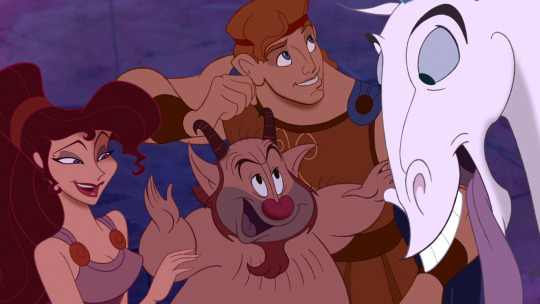
Hercules
Hercules is probably my favourite Disney movie. And I also think that's where my interest in Greek mythology started. Hades is my favorite villain from this company and he's such a mood.

The Prince of Egypt
Oh dear you don't know how much I love this movie. I know every song by heart and was lucky enough to sing them with my choir. I'm a big fan of animation and despite how old is this movie, I think it remains one of the best ever produced. I cried more times over this movie than over all the others on this list combined.

Friends & Family
I only discovered this film this year but it quickly became one of my favorites. I have never laughed for so many consecutive minutes at a movie. I approached it because it's unusual to see a gay mob-themed movie, but I immediately fell in love with all the characters and the final scene remains one of the most comic I have ever seen.

Treasure Planet
I have a soft spot for animated films about great adventures and self-discovery. Jim has been my only animated crush for years, and his story has always resonated with something inside of me (maybe the desire for adventure and his recklessness, idk). Plus, of course, "'I'm Still Here" is one of the most beautiful soundtracks ever created.

Howl's Moving Castle
One of the first films I saw by Studio Ghibli and my absolute favourite. The love stories created by this Studio are always wonderful, and this one is no different. Plus I always saw myself in Sophie (especially about the crush on Howl) and, well, there's Calcifer, what more do you want?

Les Choristes
Another thing I love: movies about music. It may be that I've been playing an instrument for years and singing in choirs, but I've always cried watching kids rediscover a new side of themselves through music and songs. And these songs are composition's masterpieces. I still remember them all by heart even though French isn't my native language.

A Christmas Carol
I'm slightly obsessed with this story, with Charles Dickens and with Christmas. I was born on Christmas Eve so you can imagine how close this theme is to my heart. I have seen several versions of this story though, and for some reason, this one remains my favourite. It may be that it's different from other more colourful versions and really shows the darkness behind the original story, idk.
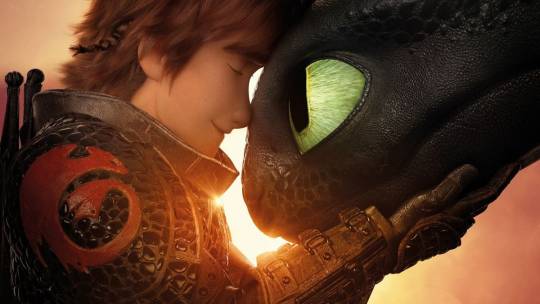
How to Train Your Dragon
I literally grew up with this saga: I was 8 years old at the first film, 12 at the second and 17 at the third. I watched Hiccup grow up with me as a friend and Toothless as a fellow adventurer. I'll forever be grateful to Dreamworks for creating the best-animated saga that cinema has ever seen.

The Three Musketeers
This movie is so random that it's perfect. I watched it again recently (after like 8 years) and realized that maybe my daddy issues come from this movie: Luke Evans, Orlando Bloom and the freaking Mads Mikkelsen together, seriously? I'm not surprised it was one of my favourite movies growing up.

A Monster in Paris
The love I have for this film is enormous. I could never get over the beauty of the songs in it. The characters are so well written and Francœur will always be in my top animated characters. It's too amazing to be real.

Rise of the Guardians
I could talk for hours about this film and have not even touched the tip of the iceberg. I have an insane obsession with all the characters, starting with and especially Jack, my top animated crush for years. It's all so perfect that I don't see how people never nominate it when it comes to top animated movies.
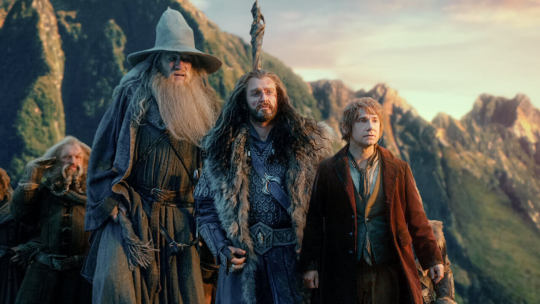
The Hobbit
Again, I have serious problems with films about fantasy adventures. I have always preferred The Hobbit saga to its sequel because the story has always fascinated me more. And the main character especially: for me Bilbo >>>> Frodo. And then there's Thorin and Luke Evans. You know, daddy issues.
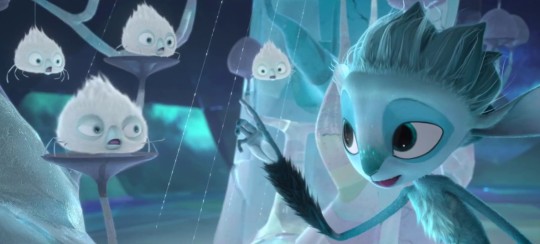
Mune: Guardian of the Moon
Another French animated movie, another obsession, another adventure, another animated character in my top. This is an example of how to do good animation. There isn't a colour out of place. The settings are authentic, the characters are original, and the adventure they make gets me every time.

Fantastic Beasts and Where to Find Them
I'm maybe a Muggle, but I prefer Fantastic Beasts to the Harry Potter saga. That's not to say it's better, mind you, but it reflects me more. We all know how we Hufflepuffs (and Ravenclaws) have no real representation in the HP movies, so to be able to have at least one prequel saga starring a Hufflepuff (in which I also find myself far too much) as the protagonist is wonderful. And I have an unhealthy urge to become a magizoologist.

The Greatest Showman
It's the movie I have watched the most of these. I know every song by heart and every line too. It always manages to be a roller coaster of emotions. And it has Hugh Jackman in it.
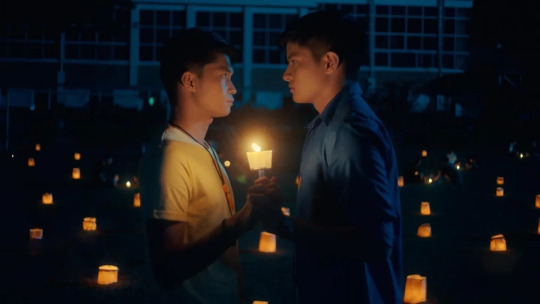
The Boy Foretold By The Stars
I'm a big supporter of the Philippine's film company. This is one movie is gentle, funny, and not based on the usual drama between Christianity and LGBT+ people (which is what I thought when reading the plot at first). Moreover, another underrated thing, the Philippines' music company here has thrown in masterpiece after masterpiece of songs, perfect for this movie.

Bros
This is my top comfort film in the last year. It's like watching a Hallmark movie but hotter, much more sincere and gay. Very gay. And the relationship between the two main characters is so cute and sweet. And funny.

Top Gun: Maverick
I love this saga but especially love this particular chapter. I love Maverick and his relationship with Rooster, and all the other characters are so well-written. And don't get me started on the story... I LOVE it. There isn't much else to say except that Cruise is a great actor (and a terrible person).

Glass Onion - Knives Out
I love my silly little gay detective. And I have a little passion for movies and mystery series. I found this saga's chapter more compelling than the first one, and the characters gripped me more. Also I fell in love with the setting. Oh and then there are Daniel Craig and Hugh Grant.
#film#movie#top#hercules#the prince of egypt#friends & family#treasure planet#howl's moving castle#les choristes#a christmas carol#httyd#the three musketeers#a monster in paris#rise of the guardians#the hobbit#mune le gardien de la lune#fantastic beasts#the greatest showman#the boy foretold by the stars#bros#top gun: maverick#glass onion
108 notes
·
View notes
Note
can i ask you to ramble about the artful dodger please?? your gifset is sooo pretty so im curious what its about!
Oh my God, have you come to the right place. There is nothing I would love to do more rn. Okay, so-
The Artful Dodger is basically (pretentious film & tv people are gonna absolutely despise this description) a post-canon/slightly canon divergent fanfiction set in the world of Dickens' Oliver Twist, following Jack Dawkins (The Artful Dodger) 15 years after the events of Oliver Twist.
So, quick recap of Oliver Twist (spoilers, obviously) for anyone who isn't familiar with that story- Oliver is this little orphan kid in England in the 18(30/40s?) << I don't believe the exact date is stated, but it was seemingly contemporary to when Dickens wrote it, which was 1837-1839. Oliver runs away from an orphanage to London and ends up meeting Jack (The Artful Dodger, AKA "Dodger" or "Dodge"), a street kid in London who takes him in. Jack is known as The Artful Dodger because he is particularly talented at pickpocketing/thieving, which is what he and the other kids he lives with do to survive. They are all "looked after" by a character called Fagin, who is basically using this child gang to support himself and his greed (listen, we can talk about Fagin's character in the show vs the books at some point if you want, but I want to keep this section brief), and Jack is the favorite because he is the best. Anyway, stuff happens, Oliver ends up having a long lost inheritance and gets to live a life of wealth, Jack is caught pickpocketing and sent to Australia (at that time a penal colony), Fagin is arrested and hanged.
*This post is relatively spoiler free for the show, but not 100%, since it's impossible to talk about without discussing character's actions, personalities, relationships, etc. However I'm doing my best to avoid any major spoiler plot points.
This show, The Artful Dodger (Hulu/Disney+) picks up 15 years later, with a few small alterations to the Oliver Twist ending. In the canon of this show, Jack was arrested for pickpocketing, but escaped prison, joined the navy, and was taught to be a surgeon. After his time in the navy, he now lives in Australia and is a doctor in a town called Port Victory, but seeing as he is also an escaped convict, he would be hanged if his past were discovered. Fagin (who dies in the original version of Oliver Twist) was spared by Oliver, and has now been sent to Port Victory as a convict. Obviously this will be a problem for Jack, who is hiding his past.
SO, with that out of the way, the premise of the show is basically this-
Jack is now a surgeon trying to live a lawful life, which is disrupted when Fagin arrives in Port Victory and threatens to expose his past and attempts to draw him back into a life of crime. Simultaneously, Jack meets Belle (totally OC for this show), the governor's daughter, who wants to be a surgeon and is willing to go to extreme lengths to get there. Unsurprisingly, Jack and Belle (who are both pretty stubborn and sassy personalities) clash in many ways, but also share common passion & interests, and thus the stage is set for the show.
So you've got two key dynamics to the show- Jack & Fagin, who have a long history (Fagin often tries to claim to be a father figure in Jack's life, which Jack rejects, as Fagin abandoned Jack when he was arrested in order to save himself) and different priorities/agendas, and Jack & Belle, who have just met, and are still trying to figure each other out. They are of very different pasts, class, mindsets/life philosophies, and this dynamic provides a lot of tension/humor/emotion (if your ask is talking about the gifset that I think, then you already know a bit about where this leads).
The show has elements of comedy, adventure, crime, romance, medical drama, etc. There are additional side plots/characters, but Belle, Jack, and Fagin are at the center of it. It's a lot of fun and only 8 eps, so I definitely recommend it to anyone who is interested! TW: blood/surgery shown on screen quite often.
Anyway, on a personal note, this show feels like it was made for me. I had this absolute obsession with The Artful Dodger character as a child; he's one of the first characters I was ever super emotionally attached to, and led to me wanting to write. For this reason, I paid to have an Artful Dodger tattoo designed while I was in college (though I have not gotten it yet, as it's part of a bigger piece that I'm still mentally workshopping) like as a reminder of why I love telling stories. So I was incredibly nervous for this show, since it was touching a character who has been fundamental to my own creative passions, so I am happy to report that it exceeded my expectations. It probably helps that I've been part of the fanfic community for a long time, so seeing "alternate" versions of characters I'm familiar with doesn't faze me too much, and I think all the actors did a great job with their performances/characters.
So if you're still here at the end of my ramblings and you think that the show sounds like a fun time, definitely check it out! I'd be willing to do a more spoilery version of one of these at some point, but I didn't want to get into heavy spoilers in a introductory post.
Thanks for asking!! <33
#the artful dodger#the artful dodger hulu#jack dawkins#belle fox#norbert fagin#ask#answered#text#long post#the artful dodger spoilers#<< but not a lot just like setting the scene (mostly stuff in the trailers)#e rambles#personal
29 notes
·
View notes
Note
on the topic of movies what genre of movies would randy like? i feel like hes a "its a wonderful life" movie kind of guy
Randy absolutely loves it's a wonderful life! He'd love Charles Dickens stories too. I'm sure the Muppets Christmas Carol is somewhere on Randy's top 10 movie list!
95 notes
·
View notes
Note
What was your favorite thing you did in the UK/Germany?
That's such a hard thing for me to say on these sorts of trips, because there are so many things that go into "favorite." Apologies that this won’t be very poetically written, I’m sitll musing on my thoughts about it.
The event I loved the most: Dickens Christmas Feast
We all know I love Charles Dickens, and even more so, we all know I love A Christmas Carol. I have seen so many versions of it, I will continue to watch versions of it, it is the best thing about Christmas, I think. So, on the one hand, very low bar to entry foe me.
On the other hand, I cannot recommend it enough to people. I would see anything this theater company did. They did such a wonderful job of building tone as you walked to where the theater was, you get this sense that you’ve about to hear something no one has ever heard before, even though this is probably one of the best known stories in the Western world. They even had a map of London from the late 1800s. I genuinely told people to just go past us in line (We had Royal Circle tickets--everything else had been sold out--so it didn’t matter if we were first or last) because they had a magnifying glass to look at the city map. It was so interesting to me to see the ways its different, but also the way its the same. What parts of the city cropped up, where were the nice areas, all of that.
I loved dressing up. I love dressing up anyhow, but it was so much fun to do it for a Victorian themed event, and people reacted so positively to the handful of us who dressed up. There was one gal who stood by us in line, turned to her mom, and said, “I told you people would dress up! We could have dressed up! I love your costumes.” and then when we thanked her and said we loved to take an opportunity, she said, “Did you bring all that from America?” and upon confirmation, she turned to her mom again and said, “They brought it from America!” I loved her, I hope next time she dresses up.
The food was shockingly good. I don’t put a lot of faith in dinner theater, foodwise, but the duck was well cooked, I love the potted cheese, and the cocktails were flat out incredible. I had smoking bishop, which I liked so much I think I’m going to try and make it at home this winter. Also, in the Royal Circle the service was incredible. Our gal Lily was so very attentive and wonderful, and she let us know that she couldn’t come out during the three acts, but in the meal breaks, she would. I let her know I was going to want to put a cocktail order in about ten minutes before each act began, and she was SO on it, like CLOCKWORK, asking me what I’d like for the next act and having hit the table RIGHT before the lights dimmed again. She was amazing.
And the play. Again, I love A Christmas Carol and I acknowledge that fully, but I never imagined that one of my favorite reworkings of it would be a one man show that is represented as Charles Dickens acting it all out of you in his deeply involved, hyperactive, scattered way. I ADORED IT. I cannot express to you how well the guy did, and how much, in moments, it really felt to me like the feeling of being a writer--especially in the earlier parts of the play--with him saying a line “wrong” and then going, “No, I don’t like that” taking up the exact same position, and redoing it. It was very much the feeling of me pacing around the office in the old days writing something. At the end of the second act, when they had this huge clap of thunder roll, lights flashing, the actor as Scrooge in this moment crying out in fear over the approach of the third ghost, and then the whole room goes pitch black and silent. It’s SO tense. The lights come up, he smiles and goes, “Pretty good, right?” ANd it just captured, for me, that feeling of knowing you’ver written something that’s going to get to your reader, and it is this MOMENT in the writing, but you’re sitting there grinning like an idiot over your desk, chuckling.
The only other players in the work, actually, were the musicians, who were live, and walked around playing the violin and little drums and other instruments, it was such an excellent way to really loop in the music aspect and give this so much more of a live feel.
The whole thing is done as a theater in the round style, and there really isn’t a bad seat in the house. I was in the royal circle, but mostly what we had was more attentive service and much more comfortable seating (They were these sumptuous plush banquettes. So nice. Everyone else was on a regular chair) because the seating was so good for the play itself. And because of how it was done, it had to have sparse staging, but what they did have was wonderful. In the center stage, especially, they had a doorframe that popped up, and when they lowered it, they couldn’t do it without a light slam, so they worked it into the play SO WELL, at one point one of the musicians was holding it for the perfect dramatic moment to hear that slam, and it was such a clever way to work in something that could have been annoying into being absolutely perfect.
It was so cleverly done, I would go see it again despite the cost of it, absolutely, if I were in London at the time.
Thing I think everyone should go see in London: Westminster Abbey.
A lot of the things I recommend are ‘use cases’ because there’s very little int his world that is uniformly bad or uniformly good, there are just good and bad use cases. I think the London Eye would be a fucking horrfying waste of time and money, but if I were bringing beeb, she might love it, as she loves to be up high. When i went with my wife one of my favorite days was when i took the train out to the shitty OW office and walked back to Mile End at the route I think Lena would take, and basically just bopped around the East End. Many people would find that boring or too much walking. I thought the British Museum was an annoying waste of my life. Many of you are audibly gasping at that statement. Use cases.
ANYHOW, Westminster Abbey is one of the only things I can think of in London that everyone she go see. I am not a big historic church person, so please trust me when I say its a very beautiful church, but it’s much more than that. I’m not sure if I just wrote this in my diary or said it here, but it feels like the collective hopes of a nation, and what it makes itself to be. What do we hold dear? What do we call ours? This is even more striking with seeing the scientists, and poets’ corner, the RAF chapel. It’s about what the UK thinks of itself as, what it hopes it is, as much as it is anything else, and I think you get a fantastic sense of that HOPE going through there. There’s a reason Oliver Crowmwell was there, and then wasn’t. Its striking for me in a way churches rarely are. I love that aspect of it, my wife loved the straight history aspects of it, the craftsmanship of the building itself and the graves are absolutely worth study, if you’re a royals person, that’s where the coronation is, if you just want to hit the tourist highlights, it is a major one. I cannot recommend it highly enough.
Thing I didn’t expect to love: The Christmas Garden Path at Blenheim Palace.
I cannot express to you what a tonally bizarre journey the Blenheim path was. It was as if they asked several different people to come together and make this, but refused to allow them to speak to each other, so you jump from moment to moment and it has absolutely no unity whatsoever. You begin in a very boring “Nice lights set to Pentatonix” Christmas display that in no way prespares you for what is about to happen. At one point, in what I called, “The Annual Tory Salute to the Blitz” it is literally the glowering face of Winston Churchill, illuminated, against a backdrop of flames. If you do not believe me ask @morkaischosen who was there with me. Then we went into the “Christmas Rave” where there was, I am not joking, pulsing lights as you walk in a circle around them to techno music. Is this related to Christmas? Who knows? WHo cares! There are dancing fountains! There’s a love tunnel! One of the areas I just called “A Eurovision entry from Eastern Europe” and I was completely right. It was bonkers. It was jarring. I loved it. 10/10. Also, whoever planned it out had amazing wisdom with the drink stops, I am so serious. I never had to chug nor wait, they were spaced PERFECTLY for finishing one drink and wanting another.
But one of my actual favorite times, that I will look on with extreme fondness, is something that I think most people would have found boring to hear about: Sitting on the living room floor with @verbforverb while @tallangrycockatiel sat there and knitted, sampling whiskeys. It was not anything you’d find in a travel guide but in many ways was what I came there to do and will be one of my favorite memories (also verb trying to fucking murder me during a monring run)
24 notes
·
View notes
Note
Dying to know what you thought of the goldfinch. I never read it and am very 👀
thank god you sent this because i was about to make an incredibly long, rambling post about this but now you have prompted this, it feels less unhinged to put it into the form of a solicited answer. @.@
I....have mixed feelings about GF. Like, really mixed feelings. When I was in college, I took a seminar on opera history and we studied the opera, Wozzeck, and my professor described watching it as "an act of endurance." I felt sort of similarly about The Goldfinch. Like I'm glad I read it, and I can't wait to never read it again lmao.
It's a really well-written book--God, I want to write like her--and it is a compelling story with a lot of really great moments, but I found it to be overall less thematically incisive than TSH and, though TSH had some pacing issues, especially towards the end, The Goldfinch felt much, much more uneven. There's a lot of crossover between the two novels--unreliable narrators that are closeted queer men, so much drinking, so much drugs, etc--to the point where I thought a twist would be that they were set in the same universe and that Theo's father was somehow Richard Papen. But TSH felt bolder in a way, more satirically cutting, funnier, wilder, and younger. The Goldfinch is a sadder book, unrelentingly anxious and grief-stricken. And I do think this is sort of the point and I don't criticize it for that. It did make the melodrama of the novel's conclusion feel a little...i don't know...less justified and a little more gimmicky? And anxiety is a monotonous state so I think the GF lacked the emotional texture that made TSH much less....exhausting?
The Goldfinch is DT's ode to Dickens and there a lot of nods to Dickens in both direct references and style (the book is basically like what if uriah heep from david copperfield was psychosexually obsessed with pip from great expectations). There are certainly class dynamics here, episodic adventures, varied characters, and a lot of ruminations on providence but I did keep wondering what about Dickens drew her to tell this particular story which on a surface-level seems to ruminate on the impact of beauty, as opposed to the impact of wealth. In a lot of ways, TSH, with its commentary on class and wealth, even more over-the-top characters, feels like a better fit for Victorian literary structures.
In my wild and quite honestly unfounded speculation, I think the conclusion that I have come to is that it is a really, really personal book. Dickens was an intensely personal writer who used his own experiences, including those with his difficult father and poor upbringing and young infatuations as material, even in sort of unrealistic scenarios. I made a half-joking post about Brett Easton Ellis serving as DT's muse but I think....like...that may be true? I spent a lot of time, while reading this book, googling and reading about BEE and his erratic personality, contradictory and sometimes controversial and nihilistic media statements, and drug addiction. (Something that stood out to me was that BEE said that Patrick Bateman was based on his father, which he later retracted, to say that he felt like he was more like Patrick Bateman and wrote that book from a place of intense depression and isolation and consumption. This third-eying of oneself through the lens of the father is so Theo to me.) It's an examination of a self-destructive person but feels so clearly written from the point of view of someone who loves them--there is a real tenderness in how Theo is rendered that makes me think that it is not directly autobiographical about DT's own life but is the record of someone else who is loved and who is grieved. I have no evidence of this, truly, but this is what I keep thinking.
Some random other thoughts: one thing that @attonitos-gloria and I have talked a lot about is how DT always writes from the point of view of men who desire other men but whose desire is so hidden and buried that it becomes warped and we think that this is fascinating. @.@ The women in both TSH cannot be held as whole people in the eye of the narrator, their wholeness exists but beyond the borders of the male narrators' understanding of them. I also love how DT loves places and loves things. She creates fantasias of real places that feel like they influence the narrative and I think that's really cool.
TL;DR: I thought TSH was better, but GF was more personal and thus more messy. But it won a Pulitzer so literally what do i know.
#anna is this what you wanted#i feel like i'm just screaming outside your door#the goldfinch#donna tartt#the secret history#thistle simulations
18 notes
·
View notes